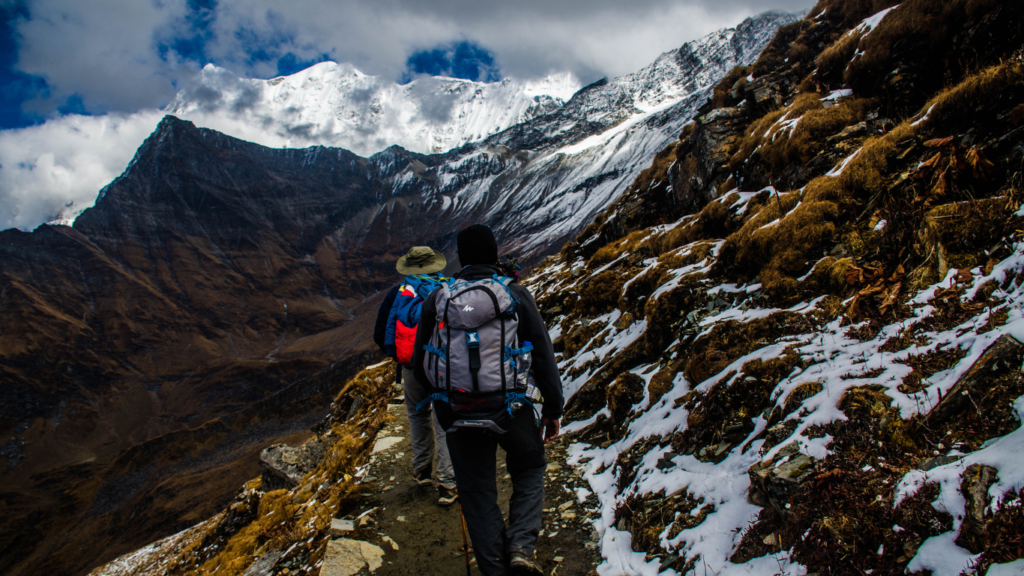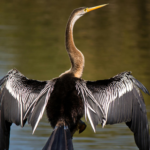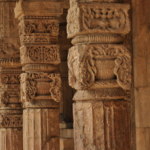The Baltal to Amarnath Cave trek is a sacred journey in the Himalayas, drawing thousands of pilgrims to worship the ice Shivling, a natural formation believed to represent Lord Shiva. This 14-kilometer trek, starting from Baltal in Jammu and Kashmir, is shorter but steeper than the Pahalgam route, offering stunning views of snow-capped peaks and rivers. It’s a mix of spiritual fulfillment and adventure, perfect for fit travelers seeking a quick pilgrimage. In this article, we’ll cover everything you need to know about the trek, from preparation to safety.
The Baltal route is popular for its shorter distance—about 14 kilometers to the Amarnath Cave—making it ideal for those with limited time. Unlike the longer Pahalgam route (36-48 km), it can be completed in one day, taking 6-8 hours. The path offers breathtaking views of the Amravati River and Himalayan peaks. However, it’s steep and challenging, best suited for younger, healthier pilgrims. The route’s direct path and helicopter options from Baltal to Panchtarni make it convenient. It’s a thrilling mix of spirituality and nature, perfect for adventure seekers.
Shorter but Steeper Path
The Baltal route’s 14-kilometer trek is a steep climb, ascending to 3,888 meters. It passes through Domail, Barari, and Sangam, with narrow, rocky paths. While shorter than Pahalgam’s route, it demands stamina due to sharp inclines. Most pilgrims complete it in a day, but the steep descent back can be tough. Fit trekkers love the challenge and scenic beauty.
Spiritual Significance
The Amarnath Cave houses the ice Shivling, a symbol of Lord Shiva’s immortality, as per Hindu beliefs. Pilgrims visit for darshan, seeking blessings and peace. The Baltal route’s quick access lets devotees focus on worship without a multi-day trek. The cave’s serene atmosphere, with smaller lingams of Parvati and Ganesh, deepens the spiritual experience.
Preparing for the Trek
Preparation is key for the Baltal to Amarnath Cave trek. You need a Compulsory Health Certificate (CHC) from authorized doctors, as required by the Shri Amarnathji Shrine Board (SASB). Register online for a permit, as spots are limited. Pack warm clothes, trekking shoes, and rain gear for the cold, unpredictable weather. Start physical training weeks before to handle the steep climb. Carry snacks and water, as food options are limited. Acclimatize in Baltal or Sonmarg to avoid altitude sickness.
Getting Your Permit
Register for the Amarnath Yatra on the SASB website, submitting your CHC. Permits are mandatory and track pilgrims for safety. Book early, as slots fill fast during the July-August season. At Baltal, present your permit and ID at checkpoints for a biometric pass. This pass is scanned along the route and returned after the trek.
Packing Essentials
Pack thermals, a jacket, gloves, and waterproof trekking shoes for the cold, high-altitude trek. A raincoat or poncho is a must, as rain is common. Bring energy bars, nuts, and a water bottle. A small first-aid kit with personal medicines helps. The site suggests a hands-free umbrella and a camera to capture the stunning views.
The Trekking Route
The Baltal to Amarnath Cave trek starts at Baltal base camp, 2,743 meters above sea level. The 14-kilometer path follows the Amravati River, passing through Domail (2 km), Barari (5 km), Sangam (4 km), and the cave (3 km). Expect steep climbs and narrow, rocky paths. Langars offer free food and tea along the way. The route’s beauty—glaciers, rivers, and peaks—makes the effort worthwhile. Most pilgrims start early morning to reach the cave by midday for darshan.
Key Stops Along the Way
From Baltal, trek 2 km to Domail, a checkpoint. Next, climb 5 km to Barari, surrounded by meadows. At Sangam, 4 km further, the Amravati and Panchtarni rivers meet. The final 3 km to the cave is steep but rewarding, with glacier views. Langars at each stop provide hot tea and snacks, keeping you energized.
Scenic Highlights
The route offers stunning Himalayan views. Snowy peaks, lush valleys, and the Amravati River create a breathtaking backdrop. Glaciers near Sangam sparkle under the sun. The site describes the peaceful vibe of the cave, with its ice lingams glowing softly. Pilgrims often stop to snap photos, capturing the serene beauty of this spiritual journey.
Travel Options to Baltal
Reaching Baltal is easy. Fly to Srinagar’s Sheikh Ul-Alam Airport, 107 km away, then drive 3.5 hours to Baltal via Sonmarg. From Jammu, it’s a 400-km road trip by bus or taxi. Trains to Jammu Tawi (330 km from Baltal) are another option, followed by a bus ride. Baltal’s base camp has tented stays and basic lodges. For comfort, stay in Sonmarg’s hotels before trekking. Book transport and lodging early for a smooth trip.
Getting to Srinagar
Srinagar’s airport connects to major Indian cities like Delhi and Mumbai. Flights take 1-2 hours, and taxis from the airport to Baltal cost around INR 3,000. Buses from Srinagar to Baltal are cheaper but take longer. The scenic drive through Sind Valley, with snowy peaks, sets the mood for the pilgrimage.
Accommodation in Baltal
Baltal offers basic tented camps with bedding and blankets. Some private lodges are available, but facilities are minimal. Sonmarg, 15 km away, has better hotels for pre-trek stays. Book tents or rooms in advance, especially during the Yatra season (July-August), as demand is high. Tents on glaciers use thermal sheets for warmth.
Trekking Tips and Safety
The Baltal route is tough, with steep climbs and high altitude (3,888 meters). Start early, around 5 AM, to avoid crowds and ensure darshan before the cave closes at 5 PM. Wear sturdy shoes for grip on rocky paths. Stay hydrated and rest at langars. Avoid trekking alone at night due to wild animals and no lighting. Medical camps along the route offer emergency help.
Physical Preparation
Train for 4-6 weeks with cardio and leg exercises like squats. Practice walking 5-10 km daily to build stamina. The steep ascent can cause breathlessness, so acclimatize in Baltal for a day. Elderly or unfit pilgrims should consider helicopter services or consult a doctor before trekking. The route isn’t ideal for kids or pregnant women.
Staying Safe
Use a guide if unfamiliar with the terrain. Stick to the marked path to avoid steep drops. Carry a flashlight for early starts. Weather can change fast, so check forecasts and pack rain gear. Past incidents, like cloudbursts, highlight the need for caution. The SASB provides security, but stay alert and avoid risky areas.
Helicopter and Other Options
For those unable to trek, helicopter services from Neelgrath (near Baltal) to Panchtarni (6 km from the cave) take 8-10 minutes, costing INR 3,000-10,000 round-trip. From Panchtarni, walk or hire ponies/dolis (INR 4,500-20,000). Dolis, carried by porters, suit elderly pilgrims. Book helicopters via the SASB website. Note: ponies aren’t allowed on the Baltal route, unlike Pahalgam. These options make the journey accessible for all.
Helicopter Booking
Book helicopter tickets early on the SASB website, as slots are limited. Flights from Neelgrath to Panchtarni save time, but you’ll trek the final 6 km or use a pony. A CHC is required for booking. Check-in early at Neelgrath for a smooth ride. Helicopters are weather-dependent, so have a backup plan.
Pony and Doli Services
Dolis cost INR 17,000-20,000 for a round trip from Panchtarni. Horse rides, available only from Panchtarni, cost INR 4,500-6,000. These are great for less-fit pilgrims but stop 2 km before the cave. Book through registered operators at Baltal or Panchtarni for safety and fair pricing.
What to Expect at the Cave
The Amarnath Cave, at 3,888 meters, houses the ice Shivling, a sacred symbol of Shiva. Smaller lingams represent Parvati and Ganesh. The cave’s cool, tranquil vibe feels divine, with the Amravati River flowing nearby. Darshan involves prayers and rituals, often lasting 30 minutes. The cave closes by 5 PM, so arrive by midday. After darshan, trek back to Baltal or stay in tents if overnighting.
Darshan Experience
Inside the cave, the ice Shivling glows softly, creating a peaceful atmosphere. Pilgrims offer prayers and take a dip in the Amravati River before darshan. The SASB manages crowds to ensure a smooth visit. The spiritual energy and natural beauty make the moment unforgettable, leaving you refreshed.
Post-Darshan Tips
After darshan, start the descent by early afternoon to reach Baltal by evening. The downhill trek is tougher on knees, so go slow. If staying overnight, book tents near the cave. Langars provide free meals, but carry snacks for energy. Return your biometric pass at Baltal checkpoints.
Why the Baltal Trek Is Special
The Baltal to Amarnath Cave trek blends adventure and devotion. Its 14-kilometer path, though challenging, rewards with Himalayan beauty and spiritual peace. The quick journey suits busy pilgrims, while langars and community vibes add warmth. With proper preparation, it’s a safe, soulful experience. Whether trekking or using helicopters, the route offers a unique way to connect with Lord Shiva’s divine presence.
Planning Your Trip
Book permits and transport early via the SASB website. Arrive in Srinagar, stay in Sonmarg for acclimatization, and trek from Baltal. July-August is best, with mild weather. Pack light but include warm clothes and sturdy shoes. The trek’s mix of challenge and beauty makes it a life-changing journey for devotees.
Lasting Memories
The trek leaves you with memories of stunning landscapes and spiritual joy. From the Amravati River’s flow to the cave’s serene aura, every step feels sacred. Sharing stories with fellow pilgrims at langars adds to the experience. The Baltal route’s unique blend of adventure and faith ensures you’ll carry its magic forever.



